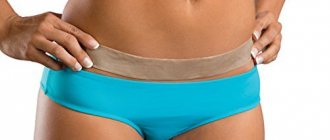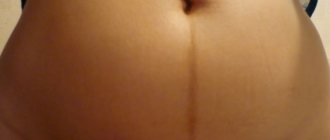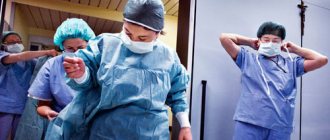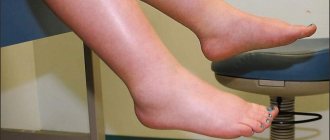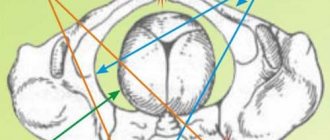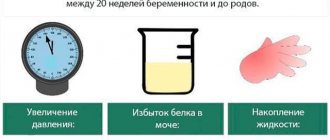The development of medicine has led to the fact that even the most complex problems associated with the birth of a baby are solved through surgical childbirth. Caesarean section is gaining popularity among women every year, as it is performed under anesthesia. The woman does not feel contractions, does not suffer from pushing, and can immediately put her baby to her breast.
Have you already seen a doctor?
Not really
It would seem that a cesarean section facilitates the process of delivery, but every woman in labor should know: open operations almost always entail complications, including adhesions after cesarean. You need to figure out why such problems arise, how to prevent them, and what therapy will be necessary if the process is not stopped in a timely manner.
What are adhesions
The doctor cuts the peritoneum and uterus to successfully remove the baby from the cavity. After this, a suture is applied, which also directly injures the tissue. The body begins to produce fibrin, a protein that promotes scarring on the surface of the damaged body. Thus, the incision site tries to stick together to avoid infection. Fibrin does not always direct its action only to the damaged area. It begins to spread to other organs, gluing them together. Such scarring after a cesarean section does not go away without consequences, which may affect the woman’s labor in the future.
Adhesions after cesarean
What are adhesions
During delivery surgery, an incision is made in the walls of the abdominal cavity and uterus, through which the fetus is removed. During the healing process of a wound, the body tries to restore the integrity of the tissue, as a result of which active scarring processes are launched.
According to doctors, the increase in connective tissue provides a protective function, preventing the inflammatory process from spreading to healthy organs.
Connective tissue makes up more than 90% of body weight, is an integral part of all organs and tissues, forming, together with blood, the internal environment through which all structural elements receive nutrients and eliminate metabolic products. Unlike most differentiated tissues, connective tissue retains the ability to regenerate into adulthood. As a result, it fills defects not only in connective tissue, but also in parenchymal organs (replacement regeneration).
Umakhanova Madina Musaevna, Doctor of Medical Sciences, Professor of the Department of Obstetrics and Gynecology, Faculty of Dentistry, Moscow State Medical University
https://lib.medvestnik.ru/articles/Sovremennye-vzglyady-na-spaechnyi-process-v-brushnoi-polosti-pri-trubno-peritonealnom-besplodii.html
In a healthy person, organs and tissues are covered with a smooth film that separates them from each other and allows them to move freely when the person moves. If any inflammatory processes or damage occur in the pelvis, a fibrin coating appears on the membrane lining the organs, which penetrates the wound and “tightens” it. If inflamed tissue comes into contact with neighboring organs, fibrin fibers “glue” them together. As a result, connecting cords or adhesions appear. They restrict the movement of organs, which causes their malfunction, and later, disruption of the structure.
Adhesions - the growth of connective tissue that “glues” neighboring organs and tissues
Reasons for the appearance of adhesions after cesarean section
An active adhesive process that spreads immediately after a cesarean section may be associated both with the work of the surgeon and with the behavior of the new mother after the manipulations. At first, the symptoms are not pronounced, besides, after giving birth, too many new concerns appear, and she does not have time to pay attention to the development of complications. Most often, the problem reveals itself with the appearance of more pronounced signs, and, accordingly, when the proliferation of adhesive fibers is in a neglected state.
Some women are predisposed to intense fibrin work, which contributes to the formation of adhesions, but their percentage is small.
In most cases, the causes of excessive scarring are due to the following:
- incorrect work of the surgeon;
- failure to comply with aseptic standards;
- long operation;
- violation of preventive recommendations.
Active scarring often affects not only the organs of the reproductive system, but also the intestines, which leads to the appearance of characteristic signs of complications.
Abdominal adhesions
The fact that the process of adhesions has captured the digestive organs will help determine disturbances in the gastrointestinal tract. They are a consequence of the fact that the intestinal loops have stuck together, peristaltic processes have been disrupted, and stagnation has begun in the stomach and intestines. The woman begins to suffer from lightheadedness and painful sensations in the abdominal area, which become more intense with exercise. Painkillers do not work; the pain goes away if you rest.
The presence of a large number of adhesions is indicated by a violation of the stool. Sometimes the process is accompanied by diarrhea, but more often stool obstruction occurs. If you have not had a bowel movement for a long time, and vomiting occurs regularly, you should immediately go to the hospital.
On the uterine suture
In the event that adhesions have grown on the suture, and the uterus is partially fused with the peritoneal tissue, signs of adhesions after cesarean section are limited to pain and heaviness below the navel. It is believed that this is the most harmless option for scarring, and if there are no problems with the gastrointestinal tract, and the presence of adhesive fibers does not interfere with conception, then there is no need to resort to treating the pathology through surgery. Open surgery may entail an even greater adhesive process.
In the pelvic area
Active growth of adhesive tissue in this area is accompanied by pain in the lower abdomen and lumbar region. A characteristic sign of adhesions of internal organs will be discomfort during sexual intercourse. If you ignore the first symptoms of this process, you can start a problem that will be difficult to eliminate in the future. Scarring on the genitals leads to blockage of the fallopian tubes. This is fraught with the fact that in the future the eggs will not be able to enter the uterus for fertilization, which can lead to infertility. But if the sperm reaches the egg, fertilization will occur directly in the fallopian tube, which will naturally result in an ectopic pregnancy.
Most often, women find out about the problem only after many unsuccessful attempts to get pregnant again. This is due to the blurred clinical picture of the disease.
How to get rid of adhesions: available treatment methods
As noted earlier, a woman who has undergone a cesarean section needs to monitor the condition of her body as closely as possible, come to the consultations prescribed by the doctor and undergo recommended examinations. The sooner it is possible to detect adhesions after cesarean section, the simpler and faster the treatment will be. In advanced cases, it is necessary to resort to surgical intervention, which is extremely undesirable, because New adhesions may appear after surgery.
In general, a specific treatment option will be selected by a qualified specialist, taking into account the individual characteristics of the condition of a particular patient. You can find information regarding existing options for getting rid of adhesions in the following table.
Table. Treatment methods for adhesions
| Available Treatment Options | Description |
| Physiotherapeutic treatment | Complex therapy, during which the patient is given injections of aloe, ozokerite applications are made to the lower abdomen and other necessary manipulations. This option allows you to get rid of “fresh” adhesions in an undeveloped state. |
| Use of enzyme preparations | After administering such drugs to the patient, the adhesive connective fibers undergo a process of partial dissolution. The adhesions soften somewhat, which allows you to get rid of them partially or completely and significantly reduce the intensity of the pain. |
| Laparoscopy | A surgical method for removing adhesions formed after the operation in question. It is used mainly in cases where adhesions affect the uterus, ovaries, and fallopian tubes and prevent fertilization. Important! After laparoscopy, adhesions very often reappear, so if a woman decides to undergo such an operation in order to become pregnant, there is no need to delay this matter. |
Why are adhesions dangerous?
On the one hand, nature has provided a protective reaction to damage to soft tissues. Active scar formation actually prevents infections from entering and spreading. But, on the other hand, excessive scar formation negatively affects the functioning of organs affected by the adhesive process.
- The spread of adhesions after cesarean section to the gastrointestinal tract is dangerous because the adhered organs cannot function normally. Stagnation leads not only to unpleasant sensations such as nausea, flatulence, heartburn, but also to more serious disorders. There is an obstruction of feces through the intestines and the impossibility of removing them. This problem can cost a person's life.
- Intense adhesions in the pelvic organs lead to infertility. Blocked fallopian tubes prevent the egg from passing through for further fertilization in the uterus.
- For the same reason, with fewer adhesions in the fallopian tubes where sperm can enter, fertilization and embryo development occurs outside the uterine cavity.
- Scars on the uterine suture lead to inflammation of the uterine mucosa, thus developing endometriosis.
If you notice the first signs of such a complication after surgical childbirth, you should immediately consult a doctor. If the problem is not resolved at the stage when the fibers are still soft and elastic, it will be very difficult to eliminate the pathology. As a rule, a young mother rarely pays attention to discomfort and other signs indicating the process of adhesions, considering this to be the norm after abdominal surgery. Even before surgical birth, it is necessary to inform the woman in labor about the consequences so that she is more attentive to her feelings after the operation.
Symptoms of adhesive disease
The main symptom of adhesive disease is pain. A woman almost constantly feels a pulling or spasmodic pain in the lower abdomen, in the lumbar region. Unpleasant sensations increase with bowel movements, physical exertion, hypothermia, and during sex.
In addition, you may experience:
- disruption of the gastrointestinal tract - possible constipation or, conversely, disorders, gas formation, bloating;
- distension in the navel area;
- temperature increase;
- dry tongue;
- difficulty in emptying. This is due to the fact that feces do not move well through those parts of the intestine that are compressed by adhesions;
- nausea, less often - vomiting;
- weakened immunity;
- possible increased heart rate;
- reproductive dysfunction.
Prevention of adhesions formation
Like most pathologies, speck formation after cesarean section is much easier to avoid than to treat. In addition, the adhesive process is difficult to diagnose. If the presence of scarring in some cases can be confirmed by ultrasound, then the patency of the fallopian tubes is checked only by a minimally invasive examination.
Before surgical childbirth, every woman should be informed about what prevention methods will help avoid complications after cesarean section:
- Movement after surgery should not be limited. As soon as the doctor allows you to get out of bed, you must move around the room independently and do not avoid activity. Only the loads should be moderate, without fanaticism, so that the fresh seam does not come apart.
- It is recommended to wear a special retaining bandage for three to six days to reduce pain and prevent suture dehiscence due to physical activity.
- Care for the baby should be complete. After a cesarean section, it is extremely important to immediately move on to normal life, and not feel sorry for yourself while lying on the bed. The movement of internal organs during active life will prevent adhesions from gluing them together.
If the operation was performed by a highly qualified specialist, then adhesions after a cesarean section are associated with improper behavior of the woman in the postpartum period. If there is a clear predisposition to the formation of scar tissue, a course of physical therapy should be taken as a preventive measure.
Types of adhesions
Laparoscopy is often used to make an accurate diagnosis. The type of adhesions is determined relative to their location.
There are adhesions:
- in the abdominal cavity;
- in the small pelvis.
Abdominal adhesions
This is the most severe type of adhesive disease. Intestinal loops become welded together, which causes many problems with the gastrointestinal tract. A dangerous problem is the development of intestinal obstruction. This always entails incessant vomiting, lack of gas discharge, and distension of the abdomen.
In this case, the patient requires urgent surgery to cut adhesions and restore intestinal patency.
Abdominal adhesions can be fatal if left untreated
Adhesions in the pelvis
Depending on the extent to which the adhesive process affected neighboring organs, as well as the degree of involvement of these organs in the formation of adhesions, 3 stages are distinguished:
- The first stage is characterized by the formation of adhesions around or on the organs of the reproductive system - the ovaries, fallopian tubes. But these organs still function perfectly and do their job.
- The second stage is the formation of adhesions between the ovary and the fallopian tube. In this case, other pelvic organs may also be involved. The fallopian tube may be pinched, making it difficult for the egg to pass through it.
- The third stage is when the egg cannot pass through the fallopian tube to the ovary because the tube is completely surrounded by adhesions, that is, it is compressed repeatedly. This can lead to an ectopic pregnancy (if a fertilized egg settles on the fallopian tube) or to the development of infertility (when, due to a pinched tube, the sperm simply cannot reach the egg).
The adhesive process of the third stage is often detected when trying to get pregnant. The woman is sent for hysterosalpinography, where dyes and x-rays are used to determine whether the dye is passing through the tubes.
Adhesions in the pelvis can form even in nulliparous women
At the age of 26, after a hysterosalpinography, I was diagnosed with obstruction of both tubes. And this is in the absence of pregnancies, operations of the reproductive system and the presence of sexually transmitted diseases. My doctor was at a loss as to how I had brought the condition of my fallopian tubes to this level. I didn’t know the answer to this question, and it was bitter to realize that my cherished dream of becoming a mother was dissipating before my eyes.
The doctor suggested performing a diagnostic laparoscopy, during which it was planned to remove numerous adhesions on the tubes. There was hope that after the operation I would be able to get pregnant.
And imagine my surprise when, having woken up and come to my senses, I learned from the doctor that both of my fallopian tubes were passable. The lack of pregnancy was hidden in a completely different disease, which could not be detected except by laparoscopy.
They explained to me that the hysterosalpinography procedure has an error in the result, since the manipulation is carried out without anesthesia and is painful. When the dye entered the pipes, they contracted or spasmed due to pain, and the doctor observed the absence of their patency on an x-ray. During laparoscopy, the opposite is true: the body, while under anesthesia, is relaxed and the patency of the tubes is easily and reliably determined.
How to treat adhesions after cesarean section
Optimal treatment of adhesions after cesarean section depends on the degree of neglect of the process. The sooner the problem is detected, the simpler the treatment method. It is impossible to treat adhesions in the later stages without surgery, and this method does not guarantee effectiveness, because the scarring process is a protective reaction both after a cesarean section and after other abdominal operations. Therefore, surgical removal of the adhesive process can cause a relapse.
Physiotherapy
If the adhesive process is at the initial stage, then a course of physiotherapy can be used as therapy. It consists of a complex of manipulations:
- Ozocerite applications.
- Paraffin therapy.
- Magnetotherapy.
- Aloe injections.
- Electrophoresis.
Physiotherapy affects the commissural fibers in such a way that they become softer, thinner, and therefore more stretchable. The pain disappears. In most cases, if the adhesions are fresh, they resolve safely.
Drug treatment
Treatment with drugs most often comes down to anti-inflammatory complexes and taking enzyme preparations: chymotrypsin, trypsin. Lidaza and Longidaza performed well. The drugs help dissolve the fibers if the problem is not advanced. Unfortunately, these medications will not help with chronic adhesive disease. In this case, only surgery can bring recovery closer.
Ultrasound therapy
With the help of ultrasound radiation, pain is relieved and scars are softened. This improves blood circulation and metabolic processes at the cellular level. The fight against adhesive fibers after cesarean section should be supported by several therapeutic methods at once. This way the effect will be maximum.
Surgically
The most popular surgical procedure for removing adhesive fibers is laparoscopy. It is used mainly when the process is advanced, when the patency of the fallopian tubes is impaired. Three small incisions are made in the abdomen, through which special micromanipulators cut the adhesive fibers and remove them. A new hole is made in the fallopian tube through which the egg will pass.
The disadvantage of surgery is the return of adhesions, therefore, if micro-operation was performed for the purpose of conception, you should not postpone the process.
Traditional methods
Alternative medicine methods are considered the safest, but in some cases even very effective. The best helpers will be:
- decoction of plantain seeds;
- St. John's wort decoction;
- tincture on boron uterus;
- cinquefoil tincture;
- drink made from aloe and milk;
- decoction of milk thistle seeds.
St. John's wort decoction
Treatment with folk remedies should also not take place without consulting a doctor. In addition, you should be careful, because many herbs, especially alcohol tinctures, cannot be used during breastfeeding.
Treatment
Medical methods
Modern medical science has not yet invented means and methods for treating adhesions that make it possible to eliminate them completely and with guaranteed success. The existing ones are able to effectively act only in cases of minor damage to organs by adhesions. This is especially true for conservative treatment methods. If we talk about surgical methods, their effectiveness is quite high, but at the same time there is a high probability of a new adhesive process occurring after surgery.
The simplest and at the same time very effective method of both treatment and prevention of the appearance of adhesions after cesarean section is considered to be the physical activity of the woman. The sooner she gets back on her feet and returns to her normal lifestyle, the less likely she is to develop this type of problem in the future.
Hirudotherapy has proven itself well in the treatment of adhesive disease.
Among conservative treatment methods (without surgical intervention), several groups can be distinguished that have a proven effect:
- Compliance with a certain diet after cesarean section (frequent and split meals), reasonable physical activity.
- Physiotherapeutic methods (effective only in the early stages of adhesive disease):
- aloe injections;
- ozokerite applications;
- mud therapy;
- hirudotherapy (treatment with leeches).
- Treatment with enzyme drugs (Lidaza, Longidaza, Chymotrypsin, Trypsin, Streptokinase). The listed drugs are used in the form of suppositories, injections, and also in combination with ultrasound or electrophoresis. Their action is aimed at softening and reducing adhesions. A good therapeutic effect from them should be expected in cases where adhesions cause pain in a woman, but enzyme preparations are not able to completely eliminate adhesions.
- A course of sodium Thiopental injection and tampons with Vishnevsky ointment gives a good absorbable effect.
- Courses of treatment with anticoagulants and antiplatelet agents that help thin the blood and prevent the formation of adhesions.
A radical method of treatment is laparoscopic surgery, during which the surgeon cuts the adhesions using one of the following methods:
- laser therapy (removal of adhesions under the influence of laser);
- aquadissection (dissection with a stream of water under high pressure);
- electrosurgery (dissection with an electric knife).
To prevent the appearance of new postoperative adhesions during laparoscopy, the following auxiliary therapy measures can be taken:
- Introduction of special substances into the cavities of organs and between them (dextran, povidine, mineral oils with glucocorticoids and others).
- Wrapping the ovaries and fallopian tubes with special polymer films that will prevent the fusion of these organs and will spontaneously resolve after some time.
Recently, it has become common practice to perform a control laparoscopy several months after the first operation, during which the adhesions are again diagnosed and, if necessary, new adhesions are eliminated.
To treat advanced adhesions in order to restore reproductive function, microsurgical operations (so-called tubal plastic surgery) are currently used. However, the effectiveness of this method in practice is not very high, and the duration of the effect of successful treatment is no more than a year. In this case, the operation is performed using the laparotomy method (by making an incision, as opposed to laparoscopy).
If the fallopian tubes are obstructed, a microsurgical operation, for example, tubal plastic surgery, may be indicated
If this last method of combating infertility caused by adhesions is ineffective, a woman has a chance to become pregnant only through in vitro fertilization (IVF). As a consolation for those who have already encountered this kind of problem, we note that women with obstruction of the fallopian tubes and the absence of other gynecological disorders are the most desirable patients for fertility doctors. This is due to the fact that for successful IVF fallopian tubes are not needed at all, and adhesions of this particular localization do not affect pregnancy in any way.
Traditional methods
There are many folk ways to deal with adhesions. Let's list the most popular ones.
Herbal decoctions
Along with medical methods of influencing adhesions, you can use folk recipes
- Decoction of plantain seeds. For 15 grams of seeds you will need a glass of boiling water. The seeds are poured with water and kept on fire for 7–8 minutes. The chilled decoction is taken 3 teaspoons three times a day half an hour before meals.
- St. John's wort decoction. Fifteen grams of dry herb are poured into a glass of hot water and boiled for about 10 minutes. Take a quarter glass three times a day for three months.
- Milk thistle decoction is prepared in the same way and in the same proportions as the previous decoctions. You should take one glass daily;
- Herbal tea. You will need two tbsp. spoons of dry nettle and rose hips, one spoon of lingonberries. A tablespoon of the resulting mixture is poured with a glass of boiling water and left for several hours. Take half a glass per day;
- A decoction of coltsfoot, centaury and sweet clover. Mix the ingredients in equal parts. One tablespoon of the resulting mixture is poured into a glass of boiling water and left for several hours in a thermos. Take a quarter glass before each meal for a month.
Herbs for treating adhesions (gallery)
Coltsfoot
Rosehip berries
Milk thistle
St. John's wort
Plantain seeds
Infusions
- Tincture of boron uterus. Seventy-five grams of dry herb are poured into two glasses of vodka, left for 15 days in the dark, and shaken every day. Take 40 drops before each meal;
- Tincture of cinquefoil. Fifteen grams of dry grass are poured into a glass of vodka and kept for 20 days. Take a tablespoon daily for 45 days.
- Aloe tincture. Leaves are cut from plants older than three years and kept in the refrigerator for three days. To one part of crushed aloe leaves, add 6 parts of honey and 6 parts of baked milk. Take a tablespoon twice a day for two months.
Compress
2 tbsp. spoons of flaxseed are wrapped in thin cloth and dipped in boiling water. Leave the compress to cool in the water. Apply it to the lower abdomen at night. A long course of such treatment often produces positive results.
Such an unpleasant consequence of a cesarean section as the formation of adhesions can ultimately lead to serious complications. Therefore, it is extremely important for a woman after surgery to adhere to basic lifestyle recommendations. Physical activity within reasonable limits, proper and frequent nutrition, as well as attention to yourself is the key to successfully overcoming the postoperative period and the absence of gynecological and other health problems in the future.
How to avoid adhesions after a caesarean section
To avoid excessive growth of adhesions after a cesarean section, you should prepare in advance and find a highly professional surgeon, since the doctor’s skill is the main factor in a successful delivery. The surgeon's quick technical work will prevent the growth of adhesive fibers.
The postoperative period plays an important role. Of course, a caesarean section is performed under general or local anesthesia, and the woman in labor does not feel pain, but after the anesthesia wears off, the pain can be severe. In this state, a woman is morally unable to begin caring for the child and herself. However, you should move so that the adhesions do not spread throughout the body and stick together the internal organs. As soon as the doctor allows you to get out of bed, move independently, and attend to your needs, you need to do this immediately. The main preventive action will be activity.
Some physiotherapy may be prescribed by a doctor for preventive purposes. This usually happens if the woman in labor has a predisposition to the formation of adhesions.
How do adhesions form?
During surgical delivery, the doctor dissects the tissue of the abdominal wall and uterus. The doctor needs to penetrate the uterus to remove the baby, saving his life. After the doctor stitches the incision, the woman’s body tries to heal—to restore the integrity of the organ.
Such a cut can only heal with a scar. For scarring, at the first stage, the body synthesizes a special protein in the form of fibers in the blood plasma - fibrin. This protein “glues” cut tissue together, minimizing the risk of infection.
Sometimes, if the rules of asepsis and antisepsis or the rehabilitation regime are violated, fibrin “glues” not only the wound surface and “throws” threads onto surrounding organs: intestinal loops, ovaries, tubes.
Doctors' opinion
The action of fibrin is a normal protective process that accompanies various soft tissue injuries, including abdominal operations. Before surgical delivery, the woman in labor should be instructed that limited movement after cesarean section is fraught with the formation of adhesions.
The woman in labor must be informed about the symptoms of adhesions. If there is an adhesive process, you should immediately consult a doctor. After all, the sooner a problem is detected, the easier it will be to solve it. It is best to resort to conservative therapy. Surgery is appropriate as a last resort if other therapeutic regimens do not work.
Prevention
Of course, after such an operation, a woman will face a number of restrictions . She cannot -exercise after a cesarean section-, lift heavy things or put unnecessary strain on herself. But don’t forget that movement is life.
From the very first days you should slowly begin to move around, when the pain is not so strong, you will be able to take walks. Light morning exercises will also serve as an excellent prevention of complications. It is worth noting that excessive calm and an inactive lifestyle are the main reasons for their occurrence.
Diagnostics
The problem is that adhesions after a cesarean section are not diagnosed in the usual ways (using tests, for example). Ultrasound and x-rays also do not always detect them. The diagnosis is often made completely by accident if some kind of planned surgical intervention is performed. Only the young mother’s complaints about symptoms, their connection with a recent CS, as well as computed tomography and diagnostic laparoscopy are informative.
This is interesting! The laparoscopy method is by far the most informative way to examine for the presence of adhesions.
Essence of the disease
First of all, a young mother should understand what adhesions are and why they form after a cesarean section. This will allow her to avoid panic and be able to prevent complications and undesirable consequences of the growing process.
According to doctors, adhesions are a natural defensive reaction of the body that has undergone surgery. Tissues on the wall of the uterus damaged by the incision are independently restored by scarring, as the skin tightens. In some cases, this occurs not only on the wounded organ, but also in nearby places that were somehow affected during surgery.
In particular, after a cesarean section, adhesions in the pelvis (very often) or the abdominal cavity (less often) are often diagnosed. Intestinal loops may “stick together,” for example. It disrupts the functioning of internal organs and requires treatment.
Unfortunately, not all women are warned about this complication and often do not pay attention to the symptoms, which are an immediate signal of distress. Nagging, constant pain in the back, lower abdomen, as well as stomach problems are perceived by many as the norm after surgery and childbirth. In fact, this is exactly how the adhesive process manifests itself after a cesarean section, the signs of which are desirable to be caught as early as possible.
Paradox . On the one hand, adhesions are the body’s reaction to natural, independent defense against infections. On the other hand, such a good deed ultimately turns into serious complications that require medical intervention and treatment.
Symptoms
If you know at least approximately the symptoms of adhesions after a cesarean section, it is quite possible to catch the disease at the initial stage and prevent it from developing. This will save you from many complications in the future. Typical signs of the onset of the adhesive process largely depend on which organs it affected.
Small pelvis: symptoms of adhesions
1. Acute form
pain syndrome; nausea; elevated temperature; increased heart rate; sharp pain occurs on palpation; intestinal obstruction; lowering blood pressure; drowsiness, weakness.
2. Intermittent form
periodic pain; digestive disorders: constipation, diarrhea; changes in the menstrual cycle.
3. Chronic form
rare but periodic pain.
Abdominal cavity: adhesive process
constant pain; intestinal obstruction; abdominal cramps; vomit; constipation; belching; flatulence.
The difficulty is that women perceive the first symptoms of adhesions as natural consequences of childbirth and cesarean section, endure them, and try to cope with the same pain syndromes with home, familiar remedies. At this time, in the absence of proper treatment, the “gluing” of organs occurs more and more intensely. Moreover, medical diagnosis of a disease is often quite difficult and even completely random.
Keep in mind! Despite the fact that the symptoms of a chronic adhesive process that affects the pelvis are often hidden and do not prevent a woman from enjoying life, this particular form of the disease is difficult to diagnose and treat, and also leads to infertility in 90% of cases.
Diagnosis and treatment of adhesions
An additional problem with the formation of adhesions is their difficult diagnosis. Pathological areas of connective tissue are not diagnosed using laboratory tests, and are also difficult to detect on ultrasound and x-ray images. To confirm the diagnosis, laparoscopic diagnosis or computed tomography may be necessary. When making a diagnosis, maternal complaints and objective clinical symptoms are important for a qualified specialist.
It happens that pathology is discovered by chance when a woman comes for examination due to difficulties with conception.
Adhesions connecting the reproductive organs do have a negative effect on subsequent pregnancies.
It is imperative to get rid of such pathology, since neglected situations can be irreversible and lead to serious violations. It is necessary to consult a doctor as soon as possible to prescribe the correct treatment. In the early stages, doctors suggest fighting adhesions with medications that promote the resorption of connective tissue.
Conservative treatment includes:
- the use of physiotherapy methods that accelerate the resorption of connective tissue;
- the use of ultrasound with medications that contain enzymes - lidase, trypsin;
- prescribing Longidase suppositories, which can be administered rectally or vaginally, and used in mono- or combination therapy.
In more advanced situations, gynecologists may recommend surgery, but even this is only 60% effective.
